Places of escape from the world and its vanity in Podillia
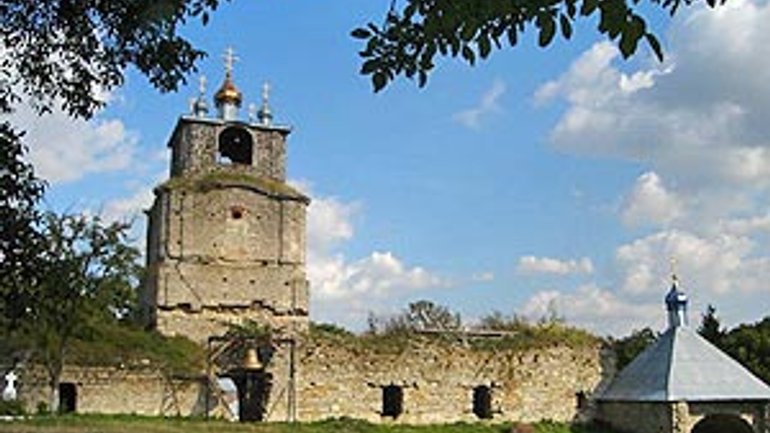
Holy Trinity Monastery and the Forest of the Recluse
There is a settlement named Sataniv at the border between west-central Ukraine’s Khmelnytskyi and Ternopil regions (Horodok District, Khmelnytsk Region). Its picturesque landscape (there is the Podillia Tovtry national nature park in the Khmelnytskyi Region and the Medobory nature reserve in the Ternopil Region), the river Zbruch, and water springs attracted our ancestors to settle in that area from ancient times. Accordingly, numerous historical events took place there. The architectural monuments of Sataniv are witnesses to this. Naturally, where people lived, religious life was active. RISU correspondent Vasyl Korshak visited Sataniv and reports about two of the numerous sights of the land, the Monastery of the Holy Trinity and the Forest of the Recluse.
How rich the Ukrainian land is in unique monuments of history! In this part of Podillia (west-central Ukraine), not far from each other are situated two unique monuments, similar and yet so different. Their similarity is in the fact that both in the monastery and in the Forest of the Recluse people sought one and the same thing, escape from the world, from its vanity. The difference is that in the monastery, people did it together, whereas in the Forest of the Recluse, an unknown man secluded himself…
Monastery of the Holy Trinity
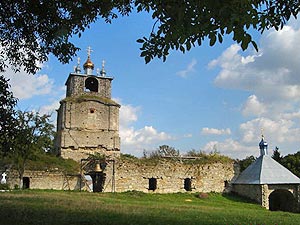 On the outskirts of Sataniv at the top of an overgrown mountain, the Monastery of the Holy Trinity is situated. It is not functioning now, but a community of the Ukrainian Orthodox Church-Moscow Patriarchate (UOC-MP) celebrates services in the preserved church.
On the outskirts of Sataniv at the top of an overgrown mountain, the Monastery of the Holy Trinity is situated. It is not functioning now, but a community of the Ukrainian Orthodox Church-Moscow Patriarchate (UOC-MP) celebrates services in the preserved church.
According to legend, the monastery was founded in the 11th century by a monk from Mount Athos. In the beginning, it was located in a cave a little lower in the forest. One can now climb a wooden staircase to the cave. The cave is also reachable through a well from the upper part of the monastery, which was built later.
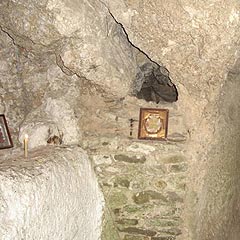 The cave is partly natural, partly cut in the limestone, which is easy to dig. Today it consists of two small cells, an underground church, and a corridor linking them. One of the cells is called the cell of trial. It contains a stone on which candidates for monastic life knelt. It was believed that only those who could kneel on it for the whole night were ready for monastic life. In the underground church, the altar stone has been preserved. Icons and a cross still rest on it. You can carry a candle and walk through the dark corridor into the narrow cells. It is dark and cool in the cave even in the summer. In the underground church, there is a small window through which one can see mountain slopes and old trees.
The cave is partly natural, partly cut in the limestone, which is easy to dig. Today it consists of two small cells, an underground church, and a corridor linking them. One of the cells is called the cell of trial. It contains a stone on which candidates for monastic life knelt. It was believed that only those who could kneel on it for the whole night were ready for monastic life. In the underground church, the altar stone has been preserved. Icons and a cross still rest on it. You can carry a candle and walk through the dark corridor into the narrow cells. It is dark and cool in the cave even in the summer. In the underground church, there is a small window through which one can see mountain slopes and old trees.
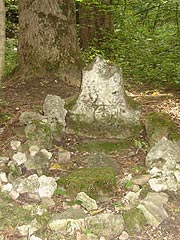 You can come out from the cave into the forest and see remains of grave stones and crosses covered with moss. They contain inscriptions in Church-Slavonic, which was used by the monks. Apparently, someone tried to put the forest cemetery in order: several graves are edged with stones, some remains of gravestones are placed at the head of the burial places.
You can come out from the cave into the forest and see remains of grave stones and crosses covered with moss. They contain inscriptions in Church-Slavonic, which was used by the monks. Apparently, someone tried to put the forest cemetery in order: several graves are edged with stones, some remains of gravestones are placed at the head of the burial places.
Let us return to the upper part. Parts of stone structures completed in 1744 have been preserved. Of the three monastery churches, one is still there. It was named in honor of the Holy Trinity. The other two churches, of the Protection and St. Nicholas, have not been preserved. One should note that many buildings of the monastery have not been preserved. The monastery was especially heavily damaged after it was closed for the second time, in 1962. The buildings then were taken apart to be used for construction of other things, particularly a cow farm. For a long time during its history the monastery was Orthodox, and from 1707 to 1793, a Greek Catholic monastery of Basilian monks was located there.
In 1893, the monastery was given to nuns. Graves have been preserved to the present on this territory. One of them is dated 1953. Mother Superior Rafaila Sviatova found her resting place then. The monastery was closed down two times, in 1929 and in 1962. After the first closing by the Soviet regime, the monastery resumed its work under occupation in 1942.
One can see traces of the barbarian attitude of the Communist authorities to the faith even now, even though the community of the UOC-MP, to which the church and remains of the monastery were passed in 1989, restored the church, and renewed a bell-tower and placed bells there. One can see the remains of wall paintings in the stone buildings of the monastic block. On a fresco with an image of the Mother of God, some barbarian hand completely destroyed the face, but the hands and shoulders remain…
In its time, the monastery was a famous spiritual and educational center. Arsenii Satanivskyi spent part of his monastic life here in the 17th century. He later contributed to compiling a Greek-Slavonic dictionary and directed the editing of prayer books which are still in use. The monastery was visited by Bohdan Khmelnytskyi (1653) and Russian Tsar Peter I (1711). The famous commander Oleksandr Suvorov visited it before his Alpine campaign.
The history of the monastery, its buildings and caves have not been studied fully and await researchers.
Forest of the Recluse
Another unique place, the Forest of the Recluse. is situated on the opposite bank of the River Zbruch, which separates the Khmelnytskyi and Ternopil regions, on the territory of the Medobory nature reserve in the Ternopil Region.
You can cross the swift-flowing Zbruch, go through the ancient village of Krentsyliv of the Husiatyn District, where household equipment of the time of Kyivan Rus has been preserved to date, and reach the forest. The road runs up the hill through old, dark deciduous woods. You can feel that it is a reserve, there are many mushrooms and plants which are entered in the Red Book.
Halfway to the cave of the recluse, another cave is situated. It is a natural cave 30 meters deep. At its very bottom, there are small lakes. Its entrance is blocked. A little higher, you can see remains of ancient protection walls. The town of Zvenyhorod was here at the time of Kyivan Rus. Later, pagans lived in these remote places for a long time after Rus had been baptized.
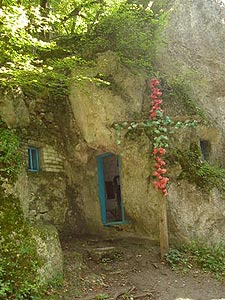 The cave of the recluse is situated at the very top of the hill. You can climb wooden stairs to get to the entrance, where there is a wooden cross. They say that the recluse came here in the 1830s. He dug a cave in the limestone for four years and lived there for about seventy years and died at a very old age. A local woman told me that her mother, who was born in the beginning of the 20th century, did not remember him alive.
The cave of the recluse is situated at the very top of the hill. You can climb wooden stairs to get to the entrance, where there is a wooden cross. They say that the recluse came here in the 1830s. He dug a cave in the limestone for four years and lived there for about seventy years and died at a very old age. A local woman told me that her mother, who was born in the beginning of the 20th century, did not remember him alive.
No one knows the name of that man or where he came from and why he decided to seclude himself in this dense forest. But it is known that he prayed constantly, and people from neighboring villages came to him to ask for prayer. The man lived on what he could find in the forest and what people brought him.
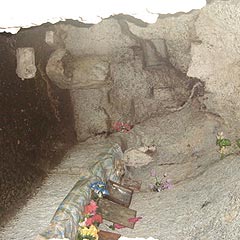 The cave consists of two rooms, in one the recluse lived, in the other he prayed. A stone bed, weak light, cold and humidity accompanied the recluse during the long time of his stay here. Now there are icons, an altar, candles in the section where he prayed. Once a year, on Pentecost, a priest and people from a neighboring village come here and celebrate services in the cave.
The cave consists of two rooms, in one the recluse lived, in the other he prayed. A stone bed, weak light, cold and humidity accompanied the recluse during the long time of his stay here. Now there are icons, an altar, candles in the section where he prayed. Once a year, on Pentecost, a priest and people from a neighboring village come here and celebrate services in the cave.
We often look for holy places abroad. But the image of holy life which is near to us will always be the closest to us.
Vasyl KORSHAK
RISU’s Ukrainian-language site posted the story on 12 April 2007.









